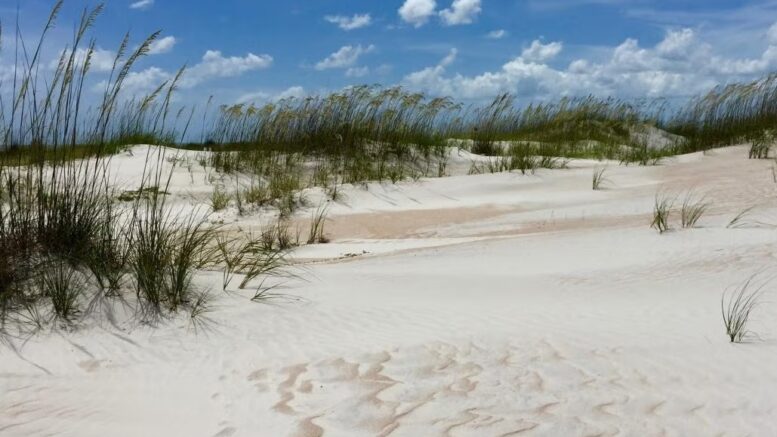By Wylie Saviello
I grew up in Atlanta, Georgia, where at the end of every school year during elementary school my family met up with other families for a long weekend at Lake Lanier. We stayed in the cabins on the campgrounds and spent hours running through the untouched woods, covering ourselves in muddy Georgia red clay, and getting pulled behind jet skis on floats. We didn’t need fancy lodges or sports courts; the simple fire pits and logs for seats did just fine for roasting smores and sharing laughs each night.
When I moved to Florida for college, I fell in love with Anastasia State Park near Flagler’s campus and the beauty of its natural land. Weeks before I started my first semester, a Florida Department of Environmental Protection (FDEP) cartographer had leaked government plans for the Great Outdoors Initiative (GOI). The Great Outdoors Initiative proposed building developments on 7 different Florida State Parks, which would compromise the natural landscapes that these parks are meant to protect. More and more, I learned the risks that national and state parks are facing and how development on park land harms the natural environments and ecosystems that survive there.
The proposed development for Florida state parks jeopardized the chance for younger generations to appreciate natural lands. I’m 19 and love the outdoors, so seeing Floridians quickly respond last August and postpone conversations around the GOI development was empowering, but they shouldn’t have had to advocate for the land in the first place.
St. Augustine is not the only home to lands that deserve protection. Fourteen percent of America’s 2.26 billion acres is accounted for special-use, most of which is for rural parks and wilderness areas, and is largely concentrated in Alaska and other states in the western half of the United States, where there are larger amounts of public lands, according to a U.S. Department of Agriculture study using data from 2017, the latest year for which complete data are available. Over 31% of all land in the State of Florida is currently designated for conservation purposes, according to the Office of Economic and Demographic Research’s 2023 Annual Assessment of Florida’s Conservation Lands.
The natural land we do have left is at risk because Florida is one of the nation’s fastest growing states. This population growth puts pressure on the state’s natural resources. The primary threat to protecting Florida’s natural lands is unchecked growth and development, which leads to the destruction of vital habitats and biodiversity, according to the Florida Wildlife Federation.
This threat to natural land is especially concerning for younger generations who have inherited the land, and the people who want to develop on it. The amount of natural land left can only decrease. Once you develop on it, you cannot go back, and I want myself and future generations to be able to continue to enjoy the serenity of preserved natural land.
The Trump administration has fired about 1,000 newly hired National Park Service employees who “maintain and clean parks” in an effort to reduce federal spending, according to an Associated Press article. These permanent staff cuts will leave hundreds of national parks “understaffed and facing tough decisions about operating hours, public safety and resource protection,” explains AP. This itself concerns me because I want to be able to get into and enjoy the parks that I cherish but may not be able to as often as I’d like.
Natural lands are not only being threatened by development, but now they will be less well taken care of and harder for patrons to access and appreciate their beauty. These recent changes come in contrast to the history of land conservation in the U.S., led initially by President Theodore Roosevelt. This drastic shift causes me to wonder how our nation’s priorities took such a turn that the wilderness valued in the beloved patriotic song “America the Beautiful,” is gradually being taken away.
Roosevelt used his authority to protect wildlife and public lands by creating the United States Forest Service (USFS) and establishing 150 national forests, 51 federal bird reserves, 4 national game preserves, 5 national parks and 18 national monuments by enabling the 1906 American Antiquities Act, according to the National Park Service website.
These efforts let us all bask in the beauty of these vast protected lands that are home to fascinating wildlife. Many of these species are now at risk of extinction. I would hate to lose the harmonies of bird songs and critters rustling leaves that give me a sense of peace when I get to enjoy them in these natural lands. Roosevelt protected approximately 230 million acres of public land during his presidency and was concerned about what would happen to our natural land and resources when they are exploited in totality.
The stark contrast between how natural land was once prioritized and is today raises major concerns for the future of America’s natural lands. There are many parks I visit regularly, and many that are on my bucket list to visit, and it would be disappointing for future generations to not have the same opportunities to witness the peaceful beauty of natural land.



Be the first to comment on "Florida State Park Development from the Perspective of a College Freshman"